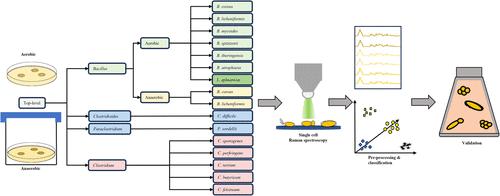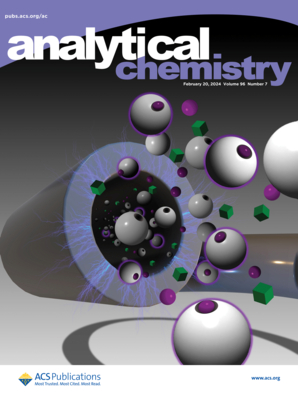Unveiling Microbial Diversity: Raman Spectroscopy’s Discrimination of Clostridium and Related Genera
IF 6.7
1区 化学
Q1 CHEMISTRY, ANALYTICAL
引用次数: 0
Abstract
In the clinical environment, the identification of phylogenetic closely related genera and species like Clostridium and Bacillus spp. is challenging. Both genera contain representatives of pathogenic and nonpathogenic species that need to be distinguished for a proper diagnostic read-out. Therefore, reliable and accurate detection methods must be employed for the correct identification of these genera and species. Despite their high pathogenicity, clostridial infections and food contaminations present significant challenges due to their unique cultivation conditions and developmental needs. Therefore, in many diagnostic protocols, the toxins are used for microbiological documentation. However, the applied laboratory methods suffer in accuracy, sometimes require large bacterial loads to provide reliable results, and cannot differentiate pathogenic from nonpathogenic strains. Here, Raman spectroscopy was employed to create an extensive Raman database consisting of pathogenic and nonpathogenic Bacillus and Clostridium species. These genera, as well as representatives of Paraclostridium and Clostridioides were specifically selected for their phylogenetic relation, cultivation conditions, and metabolic activity. A chemometric evaluation of the Raman spectra of single vegetative cells revealed a high discriminating power at the genus level. However, bacilli are considerably easier to classify at the species level than clostridia. The discrimination between the genera and species was based on their phylogeny and not their aerobic and anaerobic cultivation conditions. These encouraging results demonstrated that Raman spectroscopy coupled with chemometrics is a robust and helpful method for differentiating Clostridium species from Bacillus, Clostridioides, and Paraclostridium species. This approach has the potential to be a valuable tool in clinical diagnostics.

揭开微生物多样性的面纱:拉曼光谱鉴别梭状芽孢杆菌及相关属种
在临床环境中,梭状芽孢杆菌属和芽孢杆菌属等系统发育密切相关的属和种的鉴定具有挑战性。这两个属都包含致病性和非致病性物种的代表,需要加以区分才能得出正确的诊断结果。因此,必须采用可靠、准确的检测方法才能正确识别这些属和种。尽管梭菌具有很高的致病性,但由于其独特的培养条件和发育需求,梭菌感染和食品污染带来了巨大的挑战。因此,在许多诊断方案中,毒素被用于微生物记录。然而,应用的实验室方法准确性不高,有时需要大量细菌才能提供可靠的结果,而且无法区分致病性和非致病性菌株。在这里,拉曼光谱被用来创建一个包含致病性和非致病性芽孢杆菌和梭状芽孢杆菌的庞大拉曼数据库。这些菌属以及副梭状芽孢杆菌和梭状芽孢杆菌的代表是根据它们的系统发育关系、培养条件和代谢活性特别挑选出来的。对单个无性细胞的拉曼光谱进行的化学计量学评估显示,在属一级具有很高的鉴别力。不过,杆菌比梭菌更容易在种一级进行分类。属和种之间的区分是基于它们的系统发育,而不是它们的需氧和厌氧培养条件。这些令人鼓舞的结果表明,拉曼光谱与化学计量学相结合是区分梭菌属与芽孢杆菌属、梭状芽孢杆菌属和副梭菌属的一种可靠而有用的方法。这种方法有望成为临床诊断的重要工具。
本文章由计算机程序翻译,如有差异,请以英文原文为准。
求助全文
约1分钟内获得全文
求助全文
来源期刊

Analytical Chemistry
化学-分析化学
CiteScore
12.10
自引率
12.20%
发文量
1949
审稿时长
1.4 months
期刊介绍:
Analytical Chemistry, a peer-reviewed research journal, focuses on disseminating new and original knowledge across all branches of analytical chemistry. Fundamental articles may explore general principles of chemical measurement science and need not directly address existing or potential analytical methodology. They can be entirely theoretical or report experimental results. Contributions may cover various phases of analytical operations, including sampling, bioanalysis, electrochemistry, mass spectrometry, microscale and nanoscale systems, environmental analysis, separations, spectroscopy, chemical reactions and selectivity, instrumentation, imaging, surface analysis, and data processing. Papers discussing known analytical methods should present a significant, original application of the method, a notable improvement, or results on an important analyte.
 求助内容:
求助内容: 应助结果提醒方式:
应助结果提醒方式:


